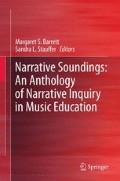Abstract
Jamie is a homeschooled student from the metro-Phoenix region of Arizona in the United States. An accomplished musician, Jamie’s resources for music education came not only from private lessons and music classes available through homeschool learning cooperatives, but also from public school, community college, and civic bands, choirs and orchestras. In this narrative case study, I present a longitudinal account of Jamie’s homeschooled education through high school and her matriculation into college and discuss Jamie’s perceptions of homeschooling, the benefits and limitations of music learning in the homeschooling environment, and the issues surrounding her attendance at the local public school to participate in music classes.
Access this chapter
Tax calculation will be finalised at checkout
Purchases are for personal use only
Notes
- 1.
For the purposes of confidentiality, the names of the participants and other identifying markers, such as the name of the high school, have been changed.
- 2.
Debbie Munoz, Homeschool Coordinator, Maricopa County School Superintendent’s Office, Phoenix, AZ (mini-disc recording).
- 3.
Candace Cochran, Homeschool Liaison Maricopa County Superintendent of Schools.
- 4.
The use of the term “public school” in the U.S. context refers to state-based school education.
- 5.
General Educational Development (or GED) tests are a group of five subject tests which, when passed, certify that the taker has American high-school level academic skills. Passing the GED grants the student the equivalent of a high-school diploma.
- 6.
Information on the Yamaha Music in Education Program, a technology-rich approach to teaching piano and general musicianship, may be accessed via the World Wide Web at www.musicineducation.com.
- 7.
Jamie distinguishes her 4 years of high school with the traditional designations of freshman, sophomore, junior and senior, even though she “graduated” from her homeschool at 16 and began attending classes at the community college. I have elected to keep her designations.
- 8.
The Regional and All-State festival orchestras are part of the Arizona Music Educators Association system of interscholastic honors orchestras available by audition.
- 9.
For many public high-school students, graduation coursework requirements and scheduling conflicts preclude participation in more than one ensemble.
References
Allsup, R.E. 2002. Crossing over: Mutual learning and democratic action in instrumental music education. Unpublished doctoral dissertation, Columbia University Teachers College.
Arai, A.B. 1999, September 6. Homeschooling and the redefinition of citizenship. Education Policy Analysis Archives 7(27). Retrieved from http://epaa.asu.edu/epaa/v7n27.html
Bielick, S. 2003, December. 1.5 million homeschooled students in the United States in 2007. US Department of Education: Institute of Education Sciences National Center for Education Statistics. Retrieved from http://nces.ed.gov/pubsearch/pubsinfo.asp?pubid=2009030
Brown, T.S. 1992. Analysis of selected variables concerning academic achievement and students receiving home schooling. Unpublished doctoral dissertation, The University of Southern Mississippi.
Children instructed at home: Eligibility to participate in interscholastic activities. 2002. Arizona Revised Statutes, 15–802.01.
Davis, S.G. 2008. Fostering a musical say: Enabling meaning making and investment in a band class by connecting to students’ informal music learning processes. Unpublished doctoral dissertation, Oakland University.
Francis, D.J. 1999. Social skills of home schooled and conventionally schooled children: A comparison study. Unpublished doctoral dissertation, Alfred University.
Green, L. 2006. Popular music education in and for itself, and for ‘other’ music: Current research in the classroom. International Journal of Music Education 24(2): 101–118.
Homes/Private School Services. n.d.. Maricopa County Superintendent of Schools. Retrieved from http://www.maricopa.gov/Schools/HomeSchool/home_school.aspx
Klicka, C.J. n.d.. HSLDA academic statistics on homeschooling. Home School Legal Defense Association. Retrieved from www.hslda.org
Lee, W.J. 1994. The socialization of home-schooled and public-schooled children. Unpublished doctoral dissertation, University of La Verne.
Lett, D.R. 1999. Home schooling and the request for access to public school extracurricular activities: A legal and policy study of Illinois. Unpublished doctoral dissertation, Illinois State University.
Lubienski, C. 2000. Whither the common good? A critique of home schooling. Peabody Journal of Education 75(1/2): 207–232.
Reich, R. 2002. The civic perils of homeschooling. Educational Leadership 59(7): 56–59.
Rudner, L. 1999. Scholastic achievement and demographic characteristics of home school students in 1998. Education Policy Analysis Archives 7. Available from http://epaa.asu.edu/ojs/article/view/543
Shyers, L.E. 1992. Comparison of social adjustment between home and traditionally schooled students. Unpublished doctoral dissertation, University of Florida.
Taylor, J.W. 1986. Self-concept in home-schooling children. Unpublished doctoral dissertation, Andrews University, Michigan.
Underage Student Program. n.d.. Chandler-Gilbert Community College. Retrieved from http://www.cgc.maricopa.edu/student-affairs/admissions/Pages/underage-student.aspx
Wiggins, J., D. Blair, J. Shively, and A. Ruthmann. 2006. A heart to heart about music education practice. The Mountain Lake Reader: Conversations on the Study and Practice of Music Teaching, 4, 82–91.
Author information
Authors and Affiliations
Corresponding author
Editor information
Editors and Affiliations
Rights and permissions
Copyright information
© 2012 Springer Science+Business Media B.V.
About this chapter
Cite this chapter
Nichols, J. (2012). Music Education in Homeschooling: Jamie’s Story. In: Barrett, M., Stauffer, S. (eds) Narrative Soundings: An Anthology of Narrative Inquiry in Music Education. Springer, Dordrecht. https://doi.org/10.1007/978-94-007-0699-6_7
Download citation
DOI: https://doi.org/10.1007/978-94-007-0699-6_7
Published:
Publisher Name: Springer, Dordrecht
Print ISBN: 978-94-007-0698-9
Online ISBN: 978-94-007-0699-6
eBook Packages: Humanities, Social Sciences and LawEducation (R0)

